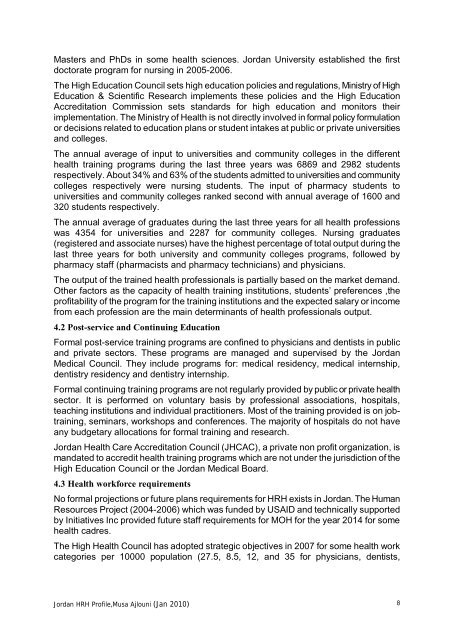Prepared by: Dr. Musa Ajlouni January, 2010 - World Health ...
Prepared by: Dr. Musa Ajlouni January, 2010 - World Health ...
Prepared by: Dr. Musa Ajlouni January, 2010 - World Health ...
Create successful ePaper yourself
Turn your PDF publications into a flip-book with our unique Google optimized e-Paper software.
Masters and PhDs in some health sciences. Jordan University established the firstdoctorate program for nursing in 2005-2006.The High Education Council sets high education policies and regulations, Ministry of HighEducation & Scientific Research implements these policies and the High EducationAccreditation Commission sets standards for high education and monitors theirimplementation. The Ministry of <strong>Health</strong> is not directly involved in formal policy formulationor decisions related to education plans or student intakes at public or private universitiesand colleges.The annual average of input to universities and community colleges in the differenthealth training programs during the last three years was 6869 and 2982 studentsrespectively. About 34% and 63% of the students admitted to universities and communitycolleges respectively were nursing students. The input of pharmacy students touniversities and community colleges ranked second with annual average of 1600 and320 students respectively.The annual average of graduates during the last three years for all health professionswas 4354 for universities and 2287 for community colleges. Nursing graduates(registered and associate nurses) have the highest percentage of total output during thelast three years for both university and community colleges programs, followed <strong>by</strong>pharmacy staff (pharmacists and pharmacy technicians) and physicians.The output of the trained health professionals is partially based on the market demand.Other factors as the capacity of health training institutions, students’ preferences ,theprofitability of the program for the training institutions and the expected salary or incomefrom each profession are the main determinants of health professionals output.4.2 Post-service and Continuing EducationFormal post-service training programs are confined to physicians and dentists in publicand private sectors. These programs are managed and supervised <strong>by</strong> the JordanMedical Council. They include programs for: medical residency, medical internship,dentistry residency and dentistry internship.Formal continuing training programs are not regularly provided <strong>by</strong> public or private healthsector. It is performed on voluntary basis <strong>by</strong> professional associations, hospitals,teaching institutions and individual practitioners. Most of the training provided is on jobtraining,seminars, workshops and conferences. The majority of hospitals do not haveany budgetary allocations for formal training and research.Jordan <strong>Health</strong> Care Accreditation Council (JHCAC), a private non profit organization, ismandated to accredit health training programs which are not under the jurisdiction of theHigh Education Council or the Jordan Medical Board.4.3 <strong>Health</strong> workforce requirementsNo formal projections or future plans requirements for HRH exists in Jordan. The HumanResources Project (2004-2006) which was funded <strong>by</strong> USAID and technically supported<strong>by</strong> Initiatives Inc provided future staff requirements for MOH for the year 2014 for somehealth cadres.The High <strong>Health</strong> Council has adopted strategic objectives in 2007 for some health workcategories per 10000 population (27.5, 8.5, 12, and 35 for physicians, dentists,Jordan HRH Profile,<strong>Musa</strong> <strong>Ajlouni</strong> (Jan <strong>2010</strong>) 8

















